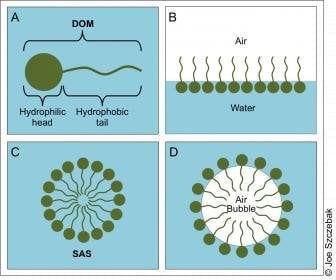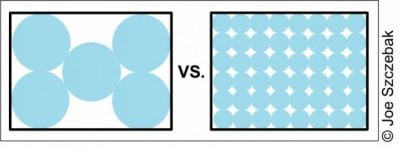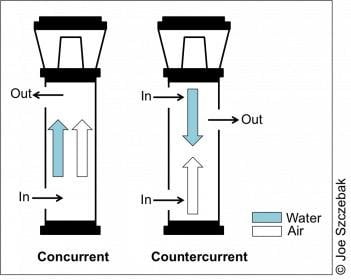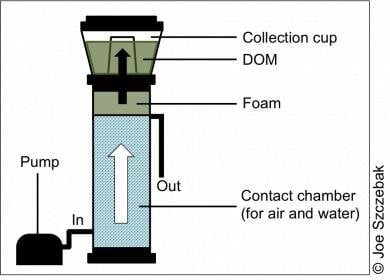BEHIND THE SCENES OF EFFECTIVE PROTEIN SKIMMING
Joe Szczebak
Overview:
Protein skimming, also known as foam fractionation, is a valuable weapon in any aquarist’s life support arsenal (Figure 1). While many aquarists utilize skimming and maintain a general understanding of how this technique works, the present article aims to (a) provide a detailed account of the biology behind protein skimming, and (b) discuss how small adjustments to your skimmer can increase the efficiency of this powerful filtration tool.

Figure 1. Anatomy of a protein skimmer.
Dissolved Organic Matter (DOM):
Before delving into the depths of protein skimming, it is necessary to understand the “enemy” we use this technique to eliminate: dissolved organic matter (DOM). DOM is a general term that incorporates a suite of organic molecules and compounds that, in excess, can wreak havoc on aquatic systems. Common culprits include many of the toxic compounds produced by corals and other sedentary organisms (e.g., sarcophine), tannins (produced by algae and other plants), and animal feces. While a broad array of compounds can be classified as DOM, they are all unified by several characteristics. First all DOM contains carbon (C) and hydrogen (H) molecules, and usually contains nitrogen (N) and phosphorous (P) as well. Further, all DOM is smaller than ~0.2 micrometers, and is thus not easily removed by many types of filtration.
So what is the big deal? Why is DOM the enemy? First, it is important to note that DOM is not bad by nature. In fact, some levels of DOM are required for the biological performance of many aquatic organisms, such as corals. However, because DOM is very small, it has a tendency to accumulate in closed systems, such as aquaria, and becomes problematic. Because DOM is rich in C, N, and P, it is basically a plant fertilizer. Thus, high concentrations of DOM can induce massive algal blooms. Further, DOM can be used as a C-source by bacteria, which subsequently release N and P as nitrate and phosphate. Elevated nitrate and phosphate levels due to microbial activity can affect the water quality of your system (i.e., decrease the dissolved oxygen, pH, and oxidation-reduction potential). Thus, it is essential to moderate DOM concentrations within your aquarium, preferably before it contacts the bacteria in your biological filtration. Fortunately, DOM has a chemical property that makes it no match for effective protein skimming!
The Weakness of DOM
DOM is considered to be amphiphillic. This means it contains both a hydrophilic (water-loving) head region and a hydrophobic (water-fearing) tail region (Figure 2A). It is the water-fearing tail region of DOM that allows it to be removed by protein skimming. These tails do not like water and are attracted to any air-water interface present in the system, such as the water surface (Figure 2B). DOM tails are also attracted to themselves, forming surface-activated substances (SAS, Figure 2C). By producing large quantities of air bubbles, protein skimming is able to attract large concentrations of DOM and SAS.

Figure 2. The amphiphillic nature of dissolved organic matter (DOM; A). The attraction and orientation of DOM to the water surface (B), to other DOM, forming surface-activated substances (SAS; C), and to an air bubble (D).
The Four Necessities of Effective Skimming:
The process of protein skimming is simple: create bubbles that attract DOM, then remove the DOM-laden bubbles from the system. However, there are four important aspects of the process that can maximize DOM removal rates:
(1) Create large quantities of small bubbles
A large number of small bubbles provides more surface area for DOM attachment than a smaller number of large bubbles that take up the same area (Figure 3). For example, one 10 mm diameter bubble fills up the same volume as 1000 1 mm diameter bubbles. However, the surface area available for DOM attachment on the 10 mm bubble is only 314.2 mm3, while the 1000 1 mm bubbles have a net surface area of 3141.6 mm3. Thus, smaller bubbles decrease the surface area:volume ratio and increase the efficiency of DOM attachment to the bubbles.

Figure 3. Visual comparison of the available surface area for DOM attachment produced by several large bubbles and many small bubbles. Both scenarios fill the same volume of water.
For smaller-scale skimmers, a limewood airstone can be used to produce a large amount of fine bubbles. However, these wooden airstones will soften and decompose over time. For larger skimmers, a venturi device (Figure 4A) and pinwheel (Figure 4B) can produce large amounts of small bubbles. The fast speed of water passing through the venturi creates suction that draws in air, which is then chopped into smaller bubbles. Positioning a rotating needle wheel after the venturi can additionally chop and mix the water and air.

Figure 4. Diagram of a venturi (A) and a rotating pin wheel (B).
(2) Maximize contact time
By maximizing the contact time between the air bubbles and water within the contact chamber of the skimmer, you increase the concentration of DOM than can bind to the bubbles. Some factors that control this contact time are bubble size, height of the contact chamber, and the concentration and size of DOM in the water. Larger bubbles contain less surface area per volume and more contact time is needed to expose DOM to that surface area. This can be accomplished by increasing the height of the contact chamber of the skimmer – the longer the distance the bubbles have to travel before reaching the collection cup, the more time for contact. Similarly, large particles of DOM (e.g., SAS) and low DOM concentrations will also require longer contact times for more efficient removal. To ensure ample contact time within the contact chamber, you can alter flow direction(s) of the water and air (Figure 5).

Figure 5. Concurrent and countercurrent input arrangements for water and air within the contact chamber of a protein skimmer. Countercurrent creates more turbulence and maximizes contact time between water and air.
(3) Make good foam
While making bubbles is necessary to sequester DOM from the water, making foam is necessary to remove those bubbles from the contact chamber of the skimmer. Simply, foam forms when small bubbles coalesce into larger, more durable bubbles. This occurs at the neck of the skimmer, between the contact chamber and the collection cup. Successful foam depends on two main properties: “drainability” and stability. The drainability of the foam allows residual water (without DOM or SAS) to flow off the foam via gravity and back into the contact chamber before the foam overflows into the collection cup. Foam stability is the ability of bubbles to not rupture during the drainage process. Stability is controlled primarily by (a) the concentration and viscosity of DOM on the bubbles, and (b) the size of the bubbles. While the concentration/viscosity of DOM on the bubbles is difficult to control, it is easy to control the size of the bubbles in the foam. If the foam gets too large, the weight of the bubbles on each other can cause them to pop, thus releasing DOM back into the water.
So, essentially, the perfect foam is a compromise between drainability and stability. For example, if the foam overflows into the collection cup too quickly and does not let excess water drain off the bubbles, the foam is considered wet and the collection cup will fill quickly due to the excess water. On the other hand, if the foam does not overflow into the collection cup quick enough, it will get large and start to dry, thus becoming less stable and prone to rupturing. Ultimately, you can control the drainability and stability of the foam by altering the water level in the contact chamber, which changes the distance the foam must grow/travel before overflowing into the collection cup. A longer distance will result in drier foam that has good drainability but decreased stability, and a shorter distance sacrifices drainability but ensures foam stability.
(4) Collect and remove the foam efficiently
The wet-or dry-nature of the foam produced will dictate the rate at which the collection cup is filled. Most of the protein skimmers appropriate for home aquaria employ relatively small collection cups that need to be emptied and cleaned frequently. One technique to increase the time between cleanings is to tap a hose line into the wall of the collection cup that drains the sequestered DOM to a larger collection container. This technique will also prevent the cup from overflowing, which will release dangerous amounts of concentrated DOM back into the aquarium.
Conclusions:
Protein skimming is a tried and true tactic for controlling levels of DOM in aquaria. While the technique is relatively easy to install and maintain, a basic understanding of the biology behind skimming can increase the efficiency and flexibility of your skimming technique. Specifically, you can increase and maintain the performance of your skimmer by (a) creating larger amounts of small bubbles, (b) optimizing the contact time of the water and bubbles within the contact chamber, (c) making foam with balanced drainability and stability, and (d) efficiently removing DOM. Happy Skimming!
Joe Szczebak
Overview:
Protein skimming, also known as foam fractionation, is a valuable weapon in any aquarist’s life support arsenal (Figure 1). While many aquarists utilize skimming and maintain a general understanding of how this technique works, the present article aims to (a) provide a detailed account of the biology behind protein skimming, and (b) discuss how small adjustments to your skimmer can increase the efficiency of this powerful filtration tool.

Figure 1. Anatomy of a protein skimmer.
Dissolved Organic Matter (DOM):
Before delving into the depths of protein skimming, it is necessary to understand the “enemy” we use this technique to eliminate: dissolved organic matter (DOM). DOM is a general term that incorporates a suite of organic molecules and compounds that, in excess, can wreak havoc on aquatic systems. Common culprits include many of the toxic compounds produced by corals and other sedentary organisms (e.g., sarcophine), tannins (produced by algae and other plants), and animal feces. While a broad array of compounds can be classified as DOM, they are all unified by several characteristics. First all DOM contains carbon (C) and hydrogen (H) molecules, and usually contains nitrogen (N) and phosphorous (P) as well. Further, all DOM is smaller than ~0.2 micrometers, and is thus not easily removed by many types of filtration.
So what is the big deal? Why is DOM the enemy? First, it is important to note that DOM is not bad by nature. In fact, some levels of DOM are required for the biological performance of many aquatic organisms, such as corals. However, because DOM is very small, it has a tendency to accumulate in closed systems, such as aquaria, and becomes problematic. Because DOM is rich in C, N, and P, it is basically a plant fertilizer. Thus, high concentrations of DOM can induce massive algal blooms. Further, DOM can be used as a C-source by bacteria, which subsequently release N and P as nitrate and phosphate. Elevated nitrate and phosphate levels due to microbial activity can affect the water quality of your system (i.e., decrease the dissolved oxygen, pH, and oxidation-reduction potential). Thus, it is essential to moderate DOM concentrations within your aquarium, preferably before it contacts the bacteria in your biological filtration. Fortunately, DOM has a chemical property that makes it no match for effective protein skimming!
The Weakness of DOM
DOM is considered to be amphiphillic. This means it contains both a hydrophilic (water-loving) head region and a hydrophobic (water-fearing) tail region (Figure 2A). It is the water-fearing tail region of DOM that allows it to be removed by protein skimming. These tails do not like water and are attracted to any air-water interface present in the system, such as the water surface (Figure 2B). DOM tails are also attracted to themselves, forming surface-activated substances (SAS, Figure 2C). By producing large quantities of air bubbles, protein skimming is able to attract large concentrations of DOM and SAS.

Figure 2. The amphiphillic nature of dissolved organic matter (DOM; A). The attraction and orientation of DOM to the water surface (B), to other DOM, forming surface-activated substances (SAS; C), and to an air bubble (D).
The Four Necessities of Effective Skimming:
The process of protein skimming is simple: create bubbles that attract DOM, then remove the DOM-laden bubbles from the system. However, there are four important aspects of the process that can maximize DOM removal rates:
(1) Create large quantities of small bubbles
A large number of small bubbles provides more surface area for DOM attachment than a smaller number of large bubbles that take up the same area (Figure 3). For example, one 10 mm diameter bubble fills up the same volume as 1000 1 mm diameter bubbles. However, the surface area available for DOM attachment on the 10 mm bubble is only 314.2 mm3, while the 1000 1 mm bubbles have a net surface area of 3141.6 mm3. Thus, smaller bubbles decrease the surface area:volume ratio and increase the efficiency of DOM attachment to the bubbles.

Figure 3. Visual comparison of the available surface area for DOM attachment produced by several large bubbles and many small bubbles. Both scenarios fill the same volume of water.
For smaller-scale skimmers, a limewood airstone can be used to produce a large amount of fine bubbles. However, these wooden airstones will soften and decompose over time. For larger skimmers, a venturi device (Figure 4A) and pinwheel (Figure 4B) can produce large amounts of small bubbles. The fast speed of water passing through the venturi creates suction that draws in air, which is then chopped into smaller bubbles. Positioning a rotating needle wheel after the venturi can additionally chop and mix the water and air.

Figure 4. Diagram of a venturi (A) and a rotating pin wheel (B).
(2) Maximize contact time
By maximizing the contact time between the air bubbles and water within the contact chamber of the skimmer, you increase the concentration of DOM than can bind to the bubbles. Some factors that control this contact time are bubble size, height of the contact chamber, and the concentration and size of DOM in the water. Larger bubbles contain less surface area per volume and more contact time is needed to expose DOM to that surface area. This can be accomplished by increasing the height of the contact chamber of the skimmer – the longer the distance the bubbles have to travel before reaching the collection cup, the more time for contact. Similarly, large particles of DOM (e.g., SAS) and low DOM concentrations will also require longer contact times for more efficient removal. To ensure ample contact time within the contact chamber, you can alter flow direction(s) of the water and air (Figure 5).

Figure 5. Concurrent and countercurrent input arrangements for water and air within the contact chamber of a protein skimmer. Countercurrent creates more turbulence and maximizes contact time between water and air.
(3) Make good foam
While making bubbles is necessary to sequester DOM from the water, making foam is necessary to remove those bubbles from the contact chamber of the skimmer. Simply, foam forms when small bubbles coalesce into larger, more durable bubbles. This occurs at the neck of the skimmer, between the contact chamber and the collection cup. Successful foam depends on two main properties: “drainability” and stability. The drainability of the foam allows residual water (without DOM or SAS) to flow off the foam via gravity and back into the contact chamber before the foam overflows into the collection cup. Foam stability is the ability of bubbles to not rupture during the drainage process. Stability is controlled primarily by (a) the concentration and viscosity of DOM on the bubbles, and (b) the size of the bubbles. While the concentration/viscosity of DOM on the bubbles is difficult to control, it is easy to control the size of the bubbles in the foam. If the foam gets too large, the weight of the bubbles on each other can cause them to pop, thus releasing DOM back into the water.
So, essentially, the perfect foam is a compromise between drainability and stability. For example, if the foam overflows into the collection cup too quickly and does not let excess water drain off the bubbles, the foam is considered wet and the collection cup will fill quickly due to the excess water. On the other hand, if the foam does not overflow into the collection cup quick enough, it will get large and start to dry, thus becoming less stable and prone to rupturing. Ultimately, you can control the drainability and stability of the foam by altering the water level in the contact chamber, which changes the distance the foam must grow/travel before overflowing into the collection cup. A longer distance will result in drier foam that has good drainability but decreased stability, and a shorter distance sacrifices drainability but ensures foam stability.
(4) Collect and remove the foam efficiently
The wet-or dry-nature of the foam produced will dictate the rate at which the collection cup is filled. Most of the protein skimmers appropriate for home aquaria employ relatively small collection cups that need to be emptied and cleaned frequently. One technique to increase the time between cleanings is to tap a hose line into the wall of the collection cup that drains the sequestered DOM to a larger collection container. This technique will also prevent the cup from overflowing, which will release dangerous amounts of concentrated DOM back into the aquarium.
Conclusions:
Protein skimming is a tried and true tactic for controlling levels of DOM in aquaria. While the technique is relatively easy to install and maintain, a basic understanding of the biology behind skimming can increase the efficiency and flexibility of your skimming technique. Specifically, you can increase and maintain the performance of your skimmer by (a) creating larger amounts of small bubbles, (b) optimizing the contact time of the water and bubbles within the contact chamber, (c) making foam with balanced drainability and stability, and (d) efficiently removing DOM. Happy Skimming!
Attachments
Last edited:

























